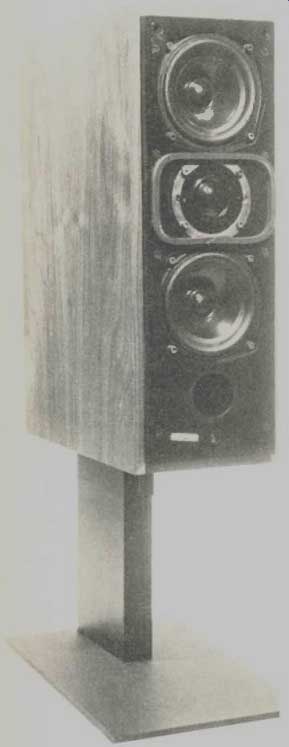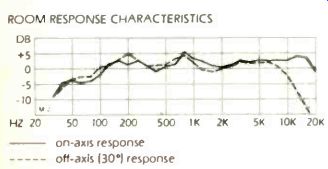An Astonishing Speaker from Great Britain

Meridian M-2 powered loudspeaker system, in wood enclosure with metal base.
Dimensions: 6 3/4" by approx. 31 inches (front; height depends on adjustment
to cant enclosure toward listening area), 14 1/2 inches deep. Price: $2,900
in rosewood, $2,700 in walnut or black ash. Warranty: "limited," three
years parts and labor. Manufacturer: Boothroyd Stuart, Ltd., England: U.S.
distributor: Anglo American Audio Co., Inc., 1080 Bellamy Road North, Scarborough,
Ont., Canada M 1 H 1H2.
"Incredible" is not a word we apply carelessly to audio, but this is one context where it belongs. Most incredible, perhaps, is the look of the front panel with the grille removed: There simply is no woofer in this full-range system. Instead, there are two 5-inch midrange drivers (with Bextrene cones, of course) flanking a dome tweeter, to which they cross over near 2 kHz. There's also a port, but it only reminds the eye that custom would lead us to expect a larger driver somewhere in the system. Powered loudspeakers still are rare enough to create some wonder, of course, but the sound itself is a more important component of the astonishment that the M-2 generates.
It is not Boothroyd Stuart's first powered Meridian speaker. The M-1 was bigger and less impressive in its conventionality; like most powered models, it made us wonder why it was powered-whether a passive model we could have driven with our own amp would not really have done as well. But one glance at the tiny drivers in the M-2 answers the question on its behalf: Only in symbiosis with a specially designed amplifier could they be expected to approach full bass response, though coupling between the two "midrange" drivers certainly gives them greater air-moving power than their size would otherwise imply. Boothroyd Stuart describes the arrangement as the acoustic equivalent of an elliptical woofer measuring about 5 by 12 inches with a concentrically mounted, time-compensated tweeter. After a few moments' reflection, therefore, amazement pales in the light of reason.
But not altogether. The salient property of the sound is its uncanny imaging, which we consistently remarked on during our listening tests. They were conducted with the speakers free-standing, well away from side and back walls, as the company's own demonstrations have consistently placed them. Once the placement has been adjusted to disengage the systems from unwanted room effects, so to speak, the air between and somewhat behind the two speakers seems to generate sound. In some unexplained way (at least to us), the imaging manages to suggest signal matrixing (Sonic Holography, etc.) without its electrical manipulation.
We used Meridian's own preamp, feeding via DIN cable to the amps built into the speakers, for most of our listening tests; but the lab and some of the listening made use of regular pin jacks that parallel the amps' DIN input sockets. The amplifier actually is listed as a biamp: a combination of a 70-watt (18 1/2-dBW) section driving the woofers and a 35-watt (15.5 dBW) section for the tweeter. The lab, of course, treated the ensemble as a "black box"; without access to the amp/driver interface, subsection measurements are impossible-and they're largely beside the point in any event.
Thus the sensitivity is stated for a 1/2-volt input (reference level for preamp outputs in the IHF standard, which we follow in our tests) instead of for the voltage equivalent of 0 dBW. Actually, most preamps have headroom for peaks of several volts, meaning that at maximum gain they could drive it to higher levels, at least instantaneously. DSL found that the tonal quality of input pulses altered audibly when pushed to peak sound pressure levels of 112 dB, implying an input waveform with peaks of approximately 2 volts. On continuous 300-Hz tones, buzzing set in at about 1 volt rms. So the capabilities of the speaker ensemble seem well matched to those of typical preamps. These upper-limit sound pressure levels don't add up to exceptional dynamic range, but they're ample for most home applications, even in quite large rooms.
Distortion proved moderate at moderate drive levels. The second harmonic averages below 1/2% above 100 Hz and rises to about 5% near the woofer resonance; the third harmonics are lower (say, 2-3%) in this range but, though they also average below 1/2% through the rest of the spectrum, exceed 1% in the 5-kHz range. When input is increased enough to deliver 100 dB SPL, there is a general rise in distortion across the board, signaling the imminence of the limits established in the 300-Hz tone and pulse tests.
All the measurements were made with the speakers four feet in front of the back wall, following the general placement recommendations of the company.
The lab comments that the bass could be strengthened by moving the speakers nearer to a room boundary, but we generally considered the bass solid sounding (startlingly so, considering the driver size) in our listening tests with them well out in the room. A/B comparisons (which were somewhat problematic because the built-in amps prevented our normal speaker switching) confirmed adequate bass but spotlighted some coloration, which may be related to the mild prominence around 800 Hz in the measured response. There were times, too, at which the M-2's sound seemed somewhat constrained or less open in comparison with that of our stalking horses.
But when comparisons were set aside and our attention turned unilaterally to the pair of M-2s, even for a very brief time, the one attribute that consistently stood out was the crystalline stereo imaging. Again, it's not just a question of stability and of unequivocal differentiation, but of somehow dissociating the sound from the speakers so that it appears to be generated in thin air. When the musical forces are small--chamber, folk, and small jazz combos, for examples--the effect can be particularly uncanny. We also found it, in varying degrees, intensely pleasurable: something some of our auditioners consistently wanted to return to after the listening chores were done.

-------------
(High Fidelity, USA print magazine)
Also see:
Altec Lansing Model 6 loudspeaker
The Critics Go Speaker Shopping [June 1981]